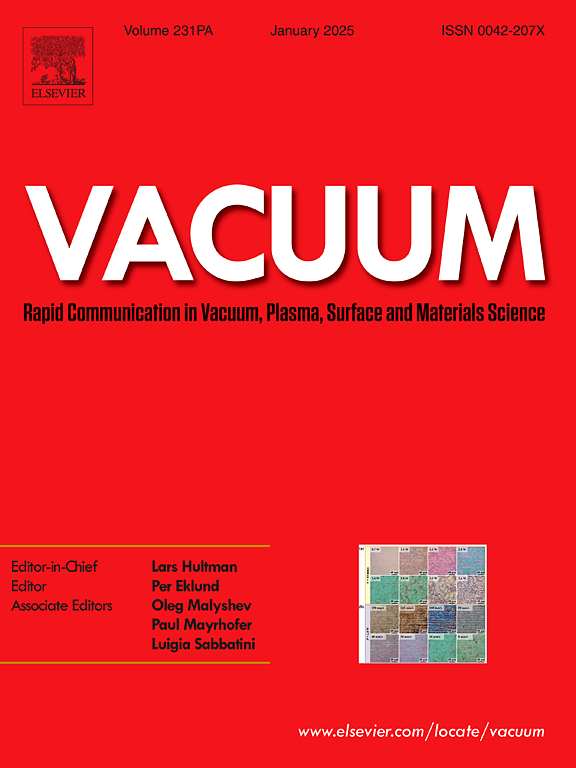微米级和纳米级CeO2颗粒对电沉积NiCo合金镀层组织、内应力和性能的影响
IF 3.8
2区 材料科学
Q2 MATERIALS SCIENCE, MULTIDISCIPLINARY
引用次数: 0
摘要
在本研究中,深入研究了微米级和纳米级CeO2颗粒对NiCo-CeO2复合镀层的表面特征、微观结构、内应力和整体性能的影响。结果表明,与纳米级镀层相比,微尺度镀层的CeO2含量更高,表面粗糙度也有所提高。此外,发现微尺度颗粒可以有效地阻止柱状晶体的生长,细化晶粒结构,从而降低微尺度镀层的织构。相反,纳米级颗粒更有效地抑制织构,从而促进纳米级镀层中更均匀的微观结构。在合金镀层中加入CeO2颗粒会增加复合镀层内部的内应力。此外,微尺度镀层比纳米尺度镀层表现出更大的内应力和变化。微米级颗粒的加入提高了NiCo-CeO2复合镀层的表面显微硬度,而纳米级颗粒的加入使镀层表面的显微硬度分布更加均匀。值得注意的是,纳米级镀层的耐腐蚀性优于微级镀层。本文章由计算机程序翻译,如有差异,请以英文原文为准。
Role of microscale and nanoscale CeO2 particles on the microstructures, internal stress and properties in electrodeposited NiCo alloy platings
In this study, a thorough investigation was undertaken to explore the effects of microscale and nanoscale CeO2 particles on the characteristics of NiCo-CeO2 composite platings, including their surface features, microstructure, internal stress, and overall performance. The results indicated that microscale platings had a higher content of CeO2, as well as increased surface roughness, when compared to nanoscale platings. Additionally, microscale particles were found to effectively prevent the growth of columnar crystals and refine grain structure, thus reducing the texture in microscale platings. Conversely, nanoscale particles were more efficient in inhibiting texture, which promoted a more uniform microstructure in the nanoscale platings. Incorporating CeO2 particles into the alloy platings increased the internal stress within the composite plating. Moreover, the microscale platings showed greater internal stress and variation in comparison with the nanoscale ones. The addition of microscale particles enhanced the surface microhardness of the NiCo-CeO2 composite platings, whereas nanoscale particles led to a more evenly distributed microhardness across the plating. Notably, the corrosion resistance of the nanoscale platings surpassed that of the microscale platings.
求助全文
通过发布文献求助,成功后即可免费获取论文全文。
去求助
来源期刊

Vacuum
工程技术-材料科学:综合
CiteScore
6.80
自引率
17.50%
发文量
0
审稿时长
34 days
期刊介绍:
Vacuum is an international rapid publications journal with a focus on short communication. All papers are peer-reviewed, with the review process for short communication geared towards very fast turnaround times. The journal also published full research papers, thematic issues and selected papers from leading conferences.
A report in Vacuum should represent a major advance in an area that involves a controlled environment at pressures of one atmosphere or below.
The scope of the journal includes:
1. Vacuum; original developments in vacuum pumping and instrumentation, vacuum measurement, vacuum gas dynamics, gas-surface interactions, surface treatment for UHV applications and low outgassing, vacuum melting, sintering, and vacuum metrology. Technology and solutions for large-scale facilities (e.g., particle accelerators and fusion devices). New instrumentation ( e.g., detectors and electron microscopes).
2. Plasma science; advances in PVD, CVD, plasma-assisted CVD, ion sources, deposition processes and analysis.
3. Surface science; surface engineering, surface chemistry, surface analysis, crystal growth, ion-surface interactions and etching, nanometer-scale processing, surface modification.
4. Materials science; novel functional or structural materials. Metals, ceramics, and polymers. Experiments, simulations, and modelling for understanding structure-property relationships. Thin films and coatings. Nanostructures and ion implantation.
 求助内容:
求助内容: 应助结果提醒方式:
应助结果提醒方式:


